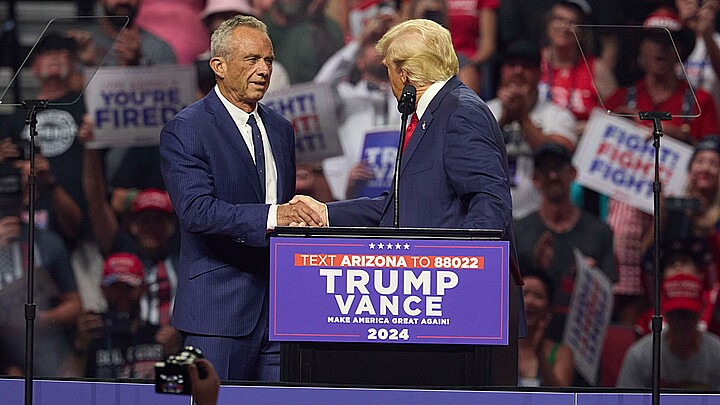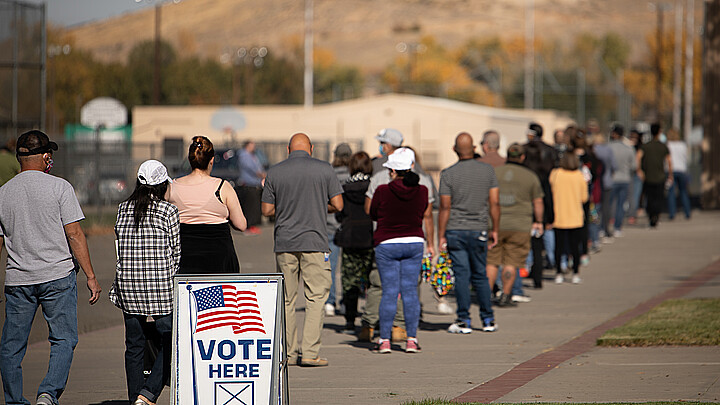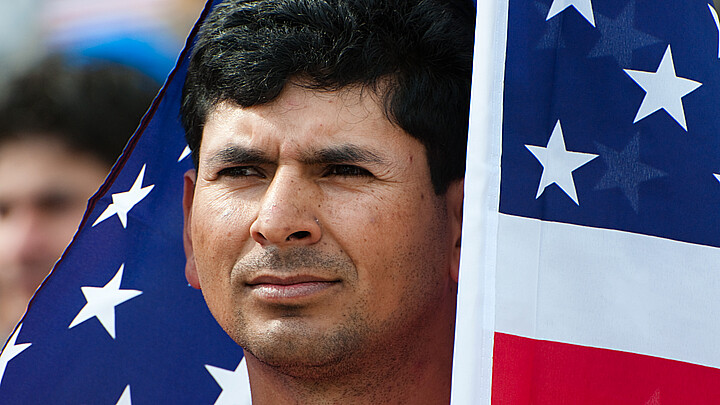Politics
Presidential candidates face uphill battle to capture young Hispanic vote
For the Democratic Party to keep the White House, Vice President Kamala Harris must win back young Hispanic voters

July 31, 2024 8:58am
Updated: August 7, 2024 7:57am
For decades, the Democratic Party could comfortably rely on Hispanic American support, especially from young voters. That base has slowly become less reliable however, as some Latinos have drifted closer to the center or the Republican Party, and some are not even sure they will even vote in this year’s presidential election. Still, young Hispanic Americans are the fastest growing demographics in the United States today, and their potential for voter impact is undeniable.
While more Hispanics still largely support the Democratic Party over the GOP, recent reports suggest that both parties should be aiming to capture the vote as a means of winning the White House.
NBC Latino reported on July 25 that Latinos are “less of a sure bet for Democrats this year than in previous election cycles,” adding that in the last election cycle, “Democrats saw then-President Donald Trump and the Republican Party carve out a larger share of the Hispanic vote in 2020.”
According to a January 2024 report published by the Pew Research Center, 59% of Latino voters voted for Joe Biden in 2020, but President Donald Trump “made gains among Hispanics” that same year.
While Democrats saw a spike across the aisle in the last presidential election, they saw a continued decline this year for President Biden, tying the two presidential candidates among Latinos.
Democrats also face the prospect of losing votes to third-party candidates.
According to a poll conducted by UnidosUS, the nation’s largest Latino advocacy group, one of every five Hispanics will be voting in their first presidential election this year.
Of those new Latino voters, 36% identify as independent or nonpartisan.
The fastest rate of any major racial and ethnic group among eligible American voters
According to the Pew Research, Latinos have grown at the second-fastest rate of any major racial and ethnic group among eligible American voters since the 2020 presidential election. Each year, approximately 1.4 million Hispanics become eligible to vote in the United States.
2020 showed an increase of 3.9 million Latino voters, a number that represents 50% of the total growth in eligible voters during that time, adding up to a total number of 36.2 million Hispanic voters across the nation.
By the time Americans cast their ballots in November for this year’s presidential election, Latinos are projected to account for 14.7% of all eligible voters in the United States, according to Pew Research.
In 2000, Hispanic Americans made up only 7.4% of U.S. eligible voters. That share climbed steadily at a rate of 153% over 20 years, increasing from 7.4% to 13.6% by 2020, and 14.7% by 2024.
Today, the majority of Hispanic Americans, 53%, are eligible to vote, and most of them tend to be younger. In fact, only 39% of Hispanic eligible voters are 50 years or older compared to 48% of the general U.S. population.
“Latinos are younger than Americans overall, and hundreds of thousands of Latino citizens turn 18 and are eligible to vote each year,” Pew wrote. “A May survey of over 2,000 voters under 40, including Latinos, found only one-third would vote for Biden. Among Latinos, 32% said they would support Trump, 28% chose Biden and another 28% said they would support "someone else," the University of Chicago GenForward survey found.”
But this does not mean either party can count on young Hispanic voters for an automatic win or even an election boost. They’ll have to earn those votes since turnout rates among Hispanic Americans voting In presidential elections are often much less than other groups, according to a recent report published by the University of Florida Election Lab.
That study found that Hispanics had a lower turnout rate than Non-Hispanic Whites, Blacks and other ethnic groups with no tie to the Hispanic or Latino culture.
An increase in young Hispanic voters in key battleground states
Traditionally Republican, some voters and media analysts were shocked when Arizona voted Democratic in 2020, handing then candidate Joe Biden the Grand Canyon State’s slate of 11 electoral votes.
One explanation for the shift was the increasing Hispanic vote in the southwest. This year, both candidates, Democratic Vice President Kamala Harris and former Republican President Donald J. Trump are battling it out to capture the state.
According to a 2024 report published by the National Association of Latino Elected and Appointed Officials (NALEO), Latinos will represent a quarter of Arizona’s vote this year with a 5% increase resulting in more than 855,000 Latinos casting ballots in the Grand Canyon State.
The report indicates that Nevada will see a 16% increase from 239,000 to 276,000 and a 14% increase in Florida from 1.8 million in 2020 to 2.0 million this year.
NALEO also suggests that an estimated 195,000 Latinos are expected to cast ballots this year in the battleground state of Georgia, a 4% increase from 2020 and a 20.8% increase from 2016. Like Arizona, Georgia also shocked the nation when it voted Democratic instead of Republican in 2020.
Still, election analysts on both sides of the aisle speculate the 2020 results in both Arizona and Georgia may have been anomalies. Trump has maintained a consistent lead in Arizona this election year, but recently showed some sign of slipping in Georgia.
According to a July 31 report published by The Hill, a poll recently commissioned by the Democratic super PAC Progress Action fund and conducted by the left-leaning Public Policy Polling Trump is leading Harris 49% to 47% in Arizona while Harris barely edges out Trump in Georgia 48% to 47%.
Young Hispanics show support for policies, but no clear allegiance to candidates in this election
On April 27, NBC published their findings from interviewing two dozen young Latino college students in Arizona, Georgia and Pennsylvania, all crucial battleground states in this year’s election.
The results revealed that while young Latinos showed consistent support for certain policies, there was little enthusiasm for either Biden or Trump as candidates on both sides of the aisle.
Some examples revealed by NBC showed the following students revealing policy preferences for Democrats, but little certainty about whether they’ll commit their vote to Harris:
In Biden’s home state of Pennsylvania, Allentown 19-year old Allentown resident Dennison Pinto says he has been looking for a viable third-party candidate. Pinto said while he prefers a Democratic president, he has not been convinced to vote for Harris or anyone else.
20-year old Jeremy Bautista voted for the first time last year in a local Pennsylvania election. She’s still undecided whether he will event vote this year. Bautista said Harris is starting to look like “one of the better options,” she’s not sure whether her views are consistent with the Democrats’ economic policy and some of their views on the Israel-Hamas conflict.
According to Stella Rouse, a political scientist at Arizona State University who spoke to the national news network, young Latino voters have “a general sense of both parties are the same, nothing’s going to change,” suggesting that candidates need to inspire young Latinos with a “message of opportunity” so they feel like they have a place in America’s future.
Carlos Odio, who co-founded Equis Research, a Democratic firm that polls Hispanic Americans, recently reported in an X social media post that data from mid-July shows that Harris may be winning back some Latinos in Nevada.
“Early read on Harris from a NV poll of Latinos (7/11-7/15): from the jump, the VP wins back some Latinos who had slipped away from Biden – and notably pulls a chunk who said they would sit out a Biden/Trump rematch,” he wrote.
According to his firm, Harris is showing both favorable and unfavorable among Latinos, but is doing better with Hispanic female than Biden did, especially those who are younger than 40.
Across the country from Harris’ home state, capturing the Latino vote has proven to be more challenging.
One of the names on Harris’ former short list of vice presidential hopefuls for Democratic North Carolina Gov. Roy Cooper. Traditionally a state that votes Republican, North Carolina offers 16 electoral votes. Cooper recently removed his name from the list, but progressive organizations such as Poder NC Action are still working in the mid-Atlantic state as they try to mobilize the Latino vote there.
According to the group, younger Latino voters are not convinced they will be well represented by either presidential candidate or political party.
Still, the 41-year old group’s founder, Irene Godinez, acknowledged that Biden passing the torch to a younger candidate left them “more optimistic than ever.” She added in an interview with NBC, "While we don’t align 100% with VP Harris, we support the choice of a new candidate who will bring a renewed spirit to the fight of our lives."
In a July 14 memo composed by Democratic pollster Matt Barreto, campaign polling reveals that Harris may have a better chance than her predecessor in capturing the young Latino vote.
According to the internal report, Harris came ahead of Biden by 46 points among Hispanics who said they disapproved of the president and former President Trump.
In a July 22 report published by The Hill, Barreto’s polling, which was conducted before Biden stepped down, the vice president’s popularity among young Hispanics ages 18-29 was 16 points better than Biden.
Barreto told NBC that Harris has a proven track record with Latinos in California from her days campaigning as a candidate for attorney general in 2010 and 2014, and 2016 for the U.S. Senate.
“She has an opportunity to reverse the media narrative that Democrats are losing Latino support because she seems to be quite popular with Latinos, and as Latinos learn more about her, I expect her favorability ratings will go up,” Barreto said.
One key issue that could have an impact on how young Hispanic women feel is abortion, an issue the Trump campaign has been careful not to enflame.
In the wake of the Supreme Court overturning Roe v. Wade, many Hispanic women now live in states such as Florida and Texas with tighter abortion restrictions. Still, some might argue those states will most assuredly vote Republican.
The candidates’ viewpoints on that issue could have more impact in battleground states with high Latino populations such as Arizona and Nevada.
According to a Pew Research report, a majority of Hispanics believe abortion should be legal in all or most cases
“Nearly three-quarters of Black and Asian adults (73% each) say abortion should be legal in all or most cases. Around six-in-ten White (59%) and Hispanic (62%) adults say the same,” Pew reported.
On July 29, a Wall Street Journal report indicated that Harris is trying to put abortion at the forefront of her campaign as a way to reach young voters.
“Polls showed that abortion was a top issue that energized Democratic voters, as well as suburban women who identify as Republicans or independents,” the Journal reported.










